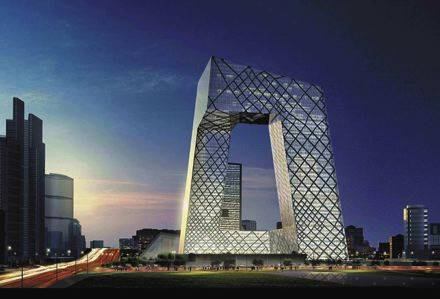
International Design
What
is the world going to look like for our children and grandchildren!!!
Think we're not being challenged from new places?
Wonders
of the New
It's a hotbed of innovative architecture, from diaphanous theaters to buildings
heated and cooled by water.

International Design
of
steel -- it's creating a stage for some of today's boldest architecture and
engineering
Take
a tour of the 10 of the most intriguing examples.
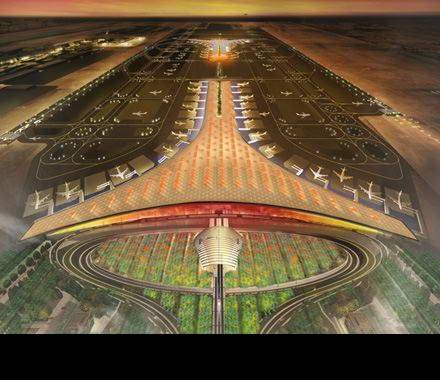
Foster
& Partners. Under construction, to be completed in late 2007. According
to the
2009
-- including what will be the world's largest: the
by
Foster & Partners. Set to open at the end of 2007, in time for the
2008,
the airport terminal will cover more than 1 million square meters, giving it
bigger footprint than the Pentagon.
It's
designed to handle 43 million passengers a year initially and 55 million by 2015
,
figures
that will probably push the new facility into the ranks of the top 10 busiest
airports ,
going
by the 2004 numbers from the Airports Council International . Given the scale
and
traffic,
Foster & Partners focused on the traveler's experience, making sure that
walking
distances
are short, for instance
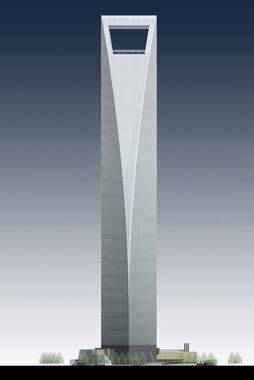
Shanghai
World Financial Center
Kohn
Pederson Fox Architects. Under construction, completion scheduled for 2008
Rising
in the Lujiazhui financial district in Pudong , the Shanghai World Financial
Center
is
a tower among towers . The elegant 101-story skyscraper will be ( for a moment,
at
least
) the world's tallest when completed in early 2008 . One of the biggest
challenges
of
building tall is creating a structure that can withstand high winds . The
architects
devised
an innovation solution to alleviate wind pressure by adding a rectangular
cut-out
at
the building's apex . Not only does the open area help reduce the building's
sway but
it
also will be home to the world's highest outdoor observation deck -- a
100th-floor
vista
that will take vertigo to new heights
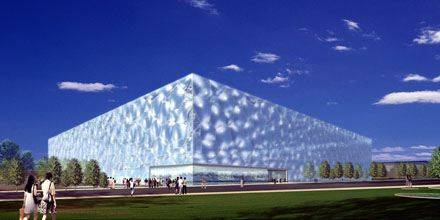
PTW
and Ove Arup. Under construction, completion scheduled for 2008. The striking
exterior
of the
and
nicknamed , the " Water Cube , " is made from panels of a lightweight
form of Teflon
that
transforms the building into an energy efficient greenhouse like environment .
Solar
energ
y will also be used to heat the swimming pools , which are designed to reuse
double
filtered
, backwashed pool water that's usually dumped as waste . Excess rainwater will
also
be collected and stored in subterranean tanks and used to fill the pools The
complex
engineering
system of curvy steel frames that form the structure of the bubble like skin are
based
on research into the structural properties of soap bubbles by two physicists at
The
unique structure is designed to help the building withstand nearly any seismic
disruptions.

Central
Chinese Television CCTV,
OMA/Ole Scheeren and Rem Koolhaas. Under construction, scheduled for completion
in
2008
The design of the new Central Chinese Television (CCTV) headquarters defies the
popular
conception of a skyscraper -- and it broke
approval
by a special review panel The standard systems for engineering gravity and
lateral
loads in buildings didn't apply to the CCTV building , which is formed by two
leaning
towers
, each bent 90 degrees at the top and bottom to form a continuous loop The
engineer's
solution is to create a structural " tube " of diagonal supports . The
irregular
pattern
of this " diagrid " system reflects the distribution of forces across
the tube's surface
Designed
by Rem Koolhaas and Ole Scheeren and engineered by Dane, Ove Arup, the new
CCTV
tower rethinks what a skyscraper can be.
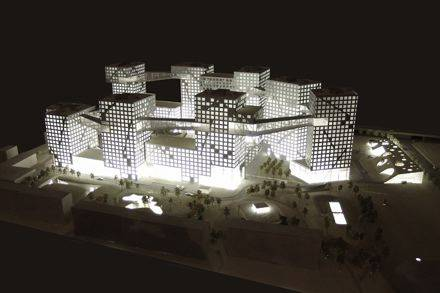
Linked
Hybrid,
Steven
Holl Architects ; Li Hu , lead architect . Groundbreaking on December 28, 2005 ,
scheduled
for completion in 2008 . Linked Hybrid , which will house 2,500 people in 700
apartments
covering 1.6 million square feet , is a model for large-scale sustainable
residential
architecture . The site will feature one of the world's largest geothermal
cooling
and
heating systems , which will stabilize the temperature within the complex of
eight
buildings
, all linked at the 20th floor by a " ring " of service establishments
, like cafes and
dry
cleaners . A set of dual pipes pumps water from 100 meters below ground ,
circulating
the
liquid between the buildings' concrete floors . The result : The water
circulation system
serves
as a giant radiator in the winter and cooling system in the summer . It has no
boilers
to
supply heat , no electric air conditioners to supply cool . The apartments also
feature
gray-water
recycling -- a process that's just starting to catch on in
buildings
-- to filter waste water from kitchen sinks and wash basins back into toilets.
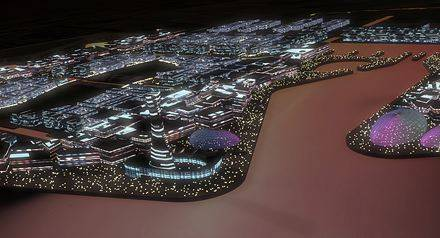
Masterplan
by Arup , for the Shanghai Industrial Investment Corp . In planning stages ,
first
phase to be completed in 2010 . Developed by the
Corp.
, Dongtan Eco City , roughly the size of Manhattan , will be the world's first
fully
sustainable
cosmopolis when completed in 2040 . Like
island
-- the third largest in
proximity
of the bustle of
2010
, the city's first phase should be completed , and 50,000 residents will call
Dongtan
home-sweet-sustainable-home
The goals to be accomplished in the next five years :
systems
for water purification , waste management , and renewable energy . An
infrastructure
of roads will connect the former agricultural land with

Olympic
Stadium,
Herzog
& de Meuron . Under construction , to be completed in 2008 . Sports stadiums
have
long followed the enduring design of one of the original wonders of the world ,
Coliseum
Herzog & de Meuron's National Stadium in
classic
sports arena layout for more ecologically correct times . The Swiss architects
(
of Tate Modern fame ) wanted to provide n atural ventilation for the 91,000-seat
structure
--
perhaps the largest " eco-friendly " sports stadium designed to date .
To achieve this ,
they
set out to create a building that could function without a strictly enclosed
shell , yet
also
provide constant shelter for the audience and athletes alike . To solve these
design
problems
, they looked to nature for inspiration . The stadium's outer grid resembles a
bird's
nest constructed of delicately placed branches and twigs Each discrete space
within
the
facility , from restrooms to restaurants , is constructed as an independent unit
within the
outer
lattice -- making it possible to encase the entire complex with an open grid
that allows
for
natural air circulation . The architects also incorporated a layer of
translucent membrane
to
fill any gaps in the lacy exterior
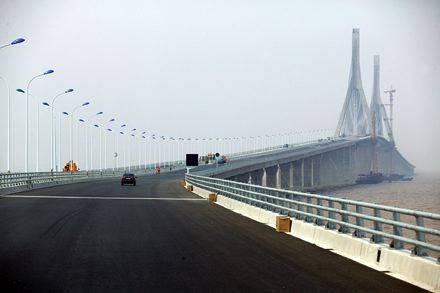
China
Zhongtie Major Bridge Engineering Group ,
Shanghai
Urban Construction Group Officially opened in December , 2005 . A key phase
in
the development of the world's largest deep-sea port was completed when
cross-sea
bridge -- the 20-mile , six-lane
December, 2005 . Stretching across the
connects
the
world's largest container port ) upon its completion in 2010 . To provide a
safer driving
route
in the typhoons and high waves known to hit the region ,
Donghai
The
structure , reported by
hold
its title of
of
years , though . In 2008 , the nearby 22-mile
also
begins ( or ends , depending on your journey ) in
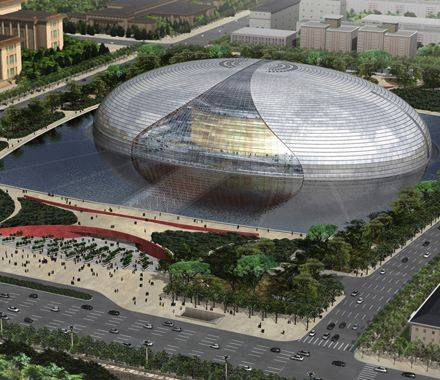
National
Grand Theater,
Paul
Andreu and ADP . Under construction , to be completed in 2008 . Located near
scheduled
to open in 2008 , seems to float above a man-made lake . Intended to stand out
amid
the Chinese capital's bustling streets and ancient buildings , the structure has
garnered
criticism among Bejing's citizens for clashing with classic landmarks like the
Monument
to the People's Heroes ( dedicated to revolutionary martyrs ) , the vast home of
the
National People's Congress , or Tiananmen Gate itself ( the Gate of Heavenly
Peace )
French
architect Paul Andreu is no stranger to controversy -- or to innovative forms .
A
generation
ago , in 1974 , his untraditional design for Terminal 1 of
Gaulle
airport was criticized for its unusual curves , yet Andreu's groundbreaking ,
futuristic
building
later was seen to distinguish de Gaulle from more generic European and
international
air hubs . ( The same airport's Terminal 2E , also designed by Andreu , gained
attention
in 2004 when it collapsed , tragically killing four people . )
will
be staged inside in the 2,416-seat opera house , the 2,017-seat concert hall ,
and the
1,040-seat
theater . At night , the semi-transparent skin will give passersby a glimpse at
the
performance
inside one of three auditoriums , a feature that highlights the building's
public nature .